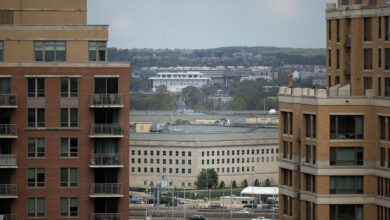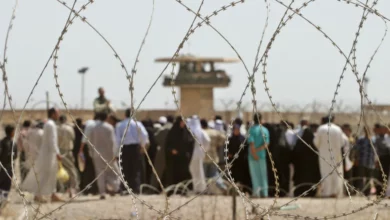
Kurdish Peshmerga forces retook a swath of northern Iraq late last month from Islamic State and days later American forces appeared in the area, the latest sign of increasing U.S. military activity in the country.
The U.S. troops, numbering about a dozen, were still there this week and spent Wednesday supervising Iraqi army engineers repairing a bridge to help local forces cross the Great Zab river in their push towards Mosul, the militants' de facto capital in Iraq which Baghdad wants to retake this year.
"We move around a lot. We've been all over the country," one of the U.S. servicemen told Reuters on the bridge, about 45 km (28 miles) southeast of Mosul. He said the Iraqis were making quick progress in repairing the span, and that the American troops would leave the area within days.
Loath to become mired in another conflict overseas, the White House has insisted there will be no American "boots on the ground" in Iraq, but current troop levels are approaching 5,000.
That is still a fraction of the 170,000 deployed at the height of the nine-year occupation that toppled Saddam Hussein in 2003, sparking an al Qaeda-backed insurgency and throwing the country into a sectarian civil war.
President Barack Obama withdrew U.S. troops from Iraq but they returned in 2014 after the Iraqi army fled Islamic State's advance through a third of the country despite billions of dollars in U.S. aid and training.
The United States is conducting an extensive air campaign over Iraq and also covert special forces raids against the jihadists behind their frontlines.
But Washington says the focus of its troops in the country is to train, advise and equip local forces – Iraqi military and police, Kurdish Peshmerga and Sunni tribal militias, which are both battling Islamic State – and that U.S. servicemen there have no combat role.
Advisers from the United States and other countries from an international coalition fighting Islamic State were initially confined to a few military bases across Iraq, but as the campaign progressed and Mosul comes into focus, Americans have inched closer to the action.
Rocket attack
A Reuters correspondent saw coalition soldiers in May outside the northern Iraqi village of Hassan Shami, a few miles east of the frontline at the time. They spoke English but their nationality was not clear. [nL8N18Q044}
While the U.S. military advisers and the soldiers who protect them do not have a combat mission, circumstances have at least occasionally blurred their role and brought them into contact with Islamic State militants.
Such encounters have only been made public three times.
Last October, Master Sergeant Joshua Wheeler was killed in a raid in Hawija where the military said U.S. special forces acting as advisers were sucked into battle when Kurdish fighters came under fire.
Then in April, a rocket attack by Islamic State killed Marine Staff Sergeant Louis Cardin at an American base near Makhmour used for protecting U.S. advisers.
A few weeks later, Petty Officer First Class Charles Keating was killed in the village of Tel Asqof where the U.S. military says he was called in as part of a "quick reaction force" to help advisers who had got caught up in a firefight.
The U.S. military, which tightly controls media access to its bases and no longer embeds reporters with troops like it did during the occupation, has tried to keep attention away from its activities in Iraq.
The soldiers who Reuters encountered on the bridge quickly turned their backs to cameras, and a Reuters request to visit Qayyara airbase, where the Pentagon is sending several hundred troops to help set up a logistics hub for the Mosul operation, was recently denied.
A military convoy heading on Monday towards the base, which was heavily damaged by fleeing Islamic State militants, contained sophisticated engineering vehicles and heavily armored transport vehicles.




